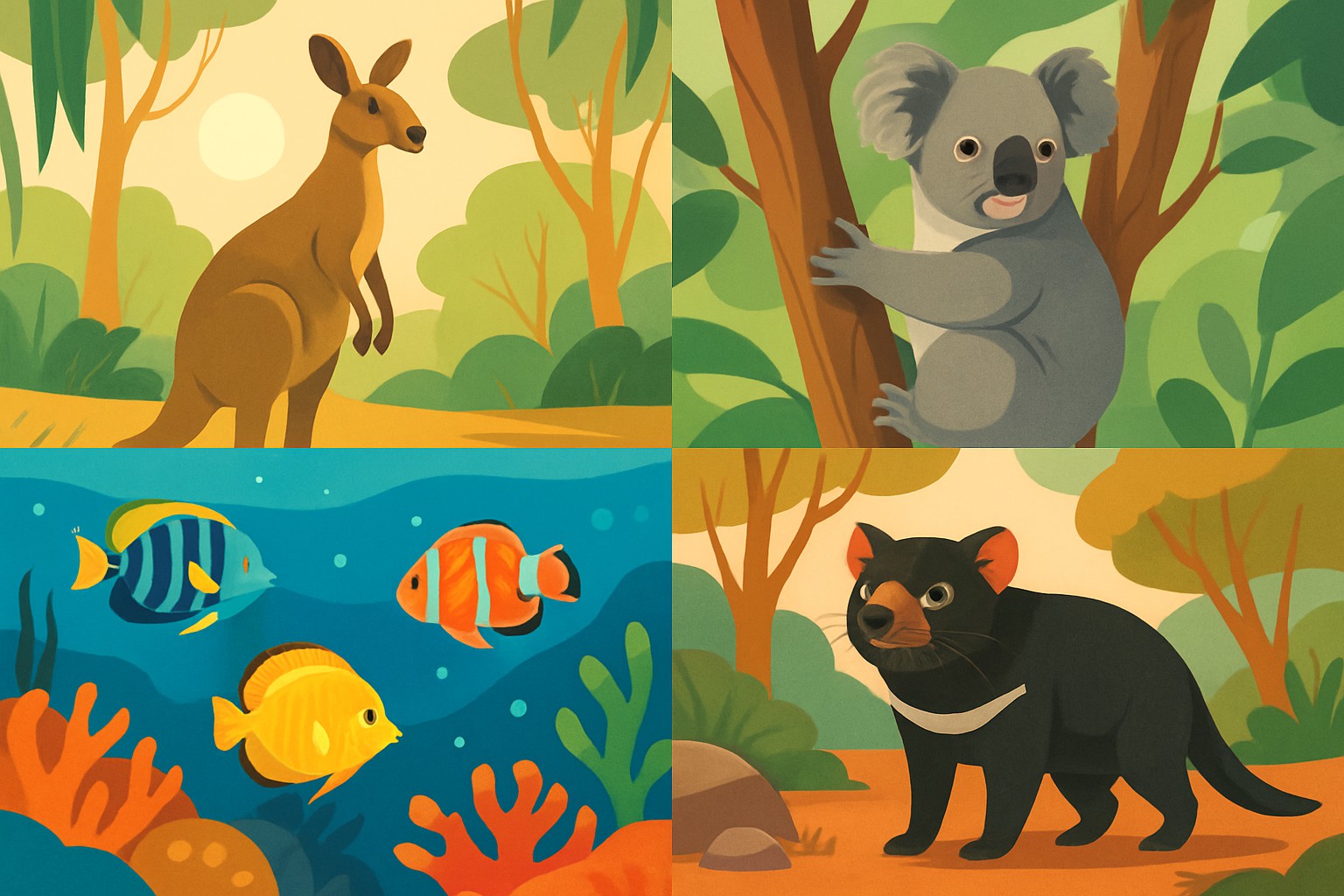Reasons to Go to Australia for Unique Wildlife Encounters

Australia is known far and wide for its astonishing wildlife and rich diverse ecosystems, making it one of the top reasons to go to Australia for travelers eager to dive into unique hands-on nature experiences. This huge island continent is a treasure trove of species you simply won’t find anywhere else. It gives you the chance to get up close and personal with iconic marsupials, brilliantly colorful birds and breathtaking marine life. It isn’t just about watching animals from a distance. Many visitors find real joy in meaningful encounters through ethical wildlife tourism, expert-led tours and conservation projects that promote responsible ways to connect with the environment.
Australia’s Unique Biodiversity: One of the Top Reasons to Go to Australia and Experience a Truly Remarkable Natural Treasure
Australia's long geographic isolation has given it a unique medley of plants and animals you will not find anywhere else. Around 80% of its mammals, birds, reptiles and amphibians call this land home and nowhere else. This makes it a fascinating showcase of evolution.
- Endemic mammals like kangaroos, koalas, wombats and possums offer wildlife encounters that stick with you long after you leave.
- Vibrant and unique birds such as emus, cockatoos, lyrebirds and the unmistakable kookaburra deliver birdwatching moments you won’t soon forget.
- Marine life from the Great Barrier Reef, including clownfish, sea turtles and the charismatic leafy sea dragon adds wonder beneath the waves.
- Reptiles and amphibians—think goannas, frilled-neck lizards and quirky frogs—thrive across Australia’s diverse habitats keeping things interesting.
- The elusive platypus, one of the rare egg-laying mammals, is a true Aussie oddity always worth the effort to spot.
- Powerful predators like saltwater crocodiles lurk in northern waterways, offering thrilling if cautious wildlife viewing opportunities.
- Rare marsupials such as the Tasmanian devil and the adorable quokka never fail to capture attention and hearts alike.
- From eucalyptus forests to the parched outback, a dazzling variety of ecosystems support these remarkable native species each with their own story to tell.
Australia is home to a whole bunch of conservation programs and some pretty robust wildlife protection laws that really do their part in keeping these unique ecosystems buzzing with life and good health.
A Rare Chance to Get Up Close and Personal with Wildlife in Australia
Travelers often zero in on Australia because it dishes up unique opportunities to spot rare and iconic species in their natural hangouts. The country's diverse landscapes—from lush rainforests bursting with life to sparkling coastal reefs and sprawling deserts that seem to go on forever—offer experiences you will not easily forget.
- Get up close and personal with iconic marsupials like kangaroos and koalas as they wander freely in protected reserves. It is like stepping into their world with no fences in the way.
- Explore a dazzling mix of habitats from lush tropical rainforests and sun-baked deserts to serene wetlands and crisp alpine regions. Each boasts its own fascinating wildlife.
- Dive or snorkel in the Great Barrier Reef to marvel at a kaleidoscope of marine life—colorful coral, curious fish, graceful turtles and gentle dugongs all making a splash.
- Roll up your sleeves with hands-on wildlife conservation projects that play a vital role in protecting species and restoring their homes.
- Catch a glimpse of nocturnal wonders like bilbies, possums and gliders during special night tours. It is a whole different animal kingdom after dark.
- Join expert-led tours and safaris for a richer take on animal behavior and ecosystems. The stories you’ll hear add layers you can’t get from casual observation.
- Back ethical and responsible wildlife tourism that is a win-win—helping local communities thrive while championing animal welfare.
Benefit 1 Getting Up Close and Personal with Iconic Species
Australia offers visitors unique opportunities to responsibly observe and connect with some of the planet's most iconic animals. Think watching playful kangaroos bounding joyfully across open fields or spotting cuddly koalas snoozing in eucalyptus trees. You might catch rare glimpses of elusive platypuses darting in crystal-clear rivers or come face-to-face with fierce Tasmanian devils prowling in national parks.
- Guided wildlife parks and sanctuaries provide a safe and ethical way to get up close with native animals without disturbing their natural groove.
- Many natural reserves are home to species like the elusive platypus and the ever-charismatic Tasmanian devil where they thrive.
- There are plenty of golden opportunities for wildlife photography and birdwatching that delight nature lovers and shutterbugs alike.
- Educational tours often provide fascinating insights into animal behavior and ecological roles as well as ongoing conservation efforts that keep these habitats buzzing.
Benefit 2 A Nice Mix of Natural Habitats That Are Easy to Get To
Australia’s vast landscape is a grand tapestry weaving together a dazzling variety of ecosystems from the steamy tropical rainforests of Queensland to the sun-baked deserts of the Outback and the temperate wetlands of Victoria. This mix supports incredible species diversity and makes it easy to experience several ecosystems in one trip. Whether you’re trekking through ancient forests to glimpse elusive shy birds or wandering along saltwater estuaries where crocodiles quietly lurk.
| Habitat Type | Location | Key Species | Best Season to Visit |
|---|---|---|---|
| Tropical Rainforest | Daintree, Queensland | Cassowaries, tree frogs, Ulysses butterflies | Spring and summer (September to February), when everything’s buzzing and bursting with life |
| Arid Desert | Simpson Desert, NT | Thorny devils, dingoes, perentie lizards | Winter (May to September), the cooler months that make exploring a bit more bearable |
| Wetlands | Kakadu National Park | Saltwater crocodiles, magpie geese, jabirus | Wet season (November to April), when the wetlands truly come alive, muddy and magnificent |
| Coastal Reefs | Great Barrier Reef | Sea turtles, clownfish, reef sharks | Winter and spring (June to November), perfect timing for crystal-clear waters and vibrant marine life |
| Temperate Forests | Tasmania | Tasmanian devils, quolls, pademelons | Summer (December to February), when the forests feel like a cool, green escape from the heat |
| Grasslands | Nullarbor Plain | Malleefowl, kangaroos, emus | Autumn (March to May), a quieter time that still offers plenty of action if you know where to look |
| Alpine Regions | Australian Alps | Mountain pygmy possum, alpine skinks | Summer (December to February), the brief window when these highlands aren’t just snow-covered and are begging to be explored |
| Mangroves | Northern Coastlines | Saltwater crocodiles, mud crabs, mangrove kingfishers | Dry season (May to October), the best time to dodge the rain and spot wildlife hanging around the roots |
Benefit 3 Diving into the Wonders of the Great Barrier Reef and Its Incredible Marine Life
The Great Barrier Reef is the largest coral reef system on the planet and offers a truly unforgettable marine wildlife adventure. Whether you’re snorkeling or diving you’ll find yourself surrounded by vibrant coral gardens full of tropical fish, curious sea turtles and a kaleidoscope of colorful invertebrates. That’s not all—venture beyond the reef and you might catch a glimpse of migrating humpback whales on their seasonal journey or spot the shy dugongs quietly grazing in shallow waters.

A vivid underwater view of the Great Barrier Reef showcasing diverse coral formations, swimming sea turtles, and an engaged snorkeler.
- Dive into some top-notch snorkeling and scuba diving in crystal-clear waters brimming with a vibrant cast of marine life.
- Get involved in hands-on marine conservation efforts focused on bringing coral reefs back to life and safeguarding those charming turtles.
- Hop on seasonal whale watching tours for unforgettable, up-close moments with majestic humpback whales as they make their epic migration.
- Join engaging educational marine biology tours led by passionate experts who happily dish out fascinating insights about the reef's vital ecological role.
Benefit 4 Lending a Hand to Conservation and Championing Ethical Wildlife Tourism
Australia is right up there at the forefront of wildlife tourism, serving up experiences that not only captivate visitors but also give conservation efforts a meaningful boost. With some pretty strict rules in place to protect endangered species and their fragile habitats, the individuals running ecotourism ventures take great care to minimize human impact.
"Responsible wildlife tourism in Australia isn’t just about ticking boxes; it plays a important role in conservation by funneling much-needed funds and shining a spotlight on the importance of our unique species. It’s a win-win, helping to safeguard these creatures for generations to come." – Dr. Emily Harris, Australian Wildlife Conservationist
Community-led projects especially those involving Indigenous Australians really steal the spotlight when it comes to wildlife preservation. By weaving together age-old traditional knowledge with the latest conservation techniques, these initiatives not only empower local communities but also act as guardians of our natural heritage.
Benefit 5 Engaging Educational Wildlife Programs That Truly Capture Your Imagination
Australia offers a delightful mix of educational wildlife experiences designed to deepen your understanding and inspire a genuine sense of stewardship. Individuals often tag along with biologists on guided tours or pitch in with citizen science projects. Many also volunteer at animal rehabilitation centers.
- Take part in wildlife research projects that track endangered species in their natural habitats. There is something truly rewarding about being on the front lines of conservation.
- Volunteer with conservation groups dedicated to restoring habitats and caring for animals. It is a hands-on way to make a real difference and you might even pick up some stories to tell.
- Join guided nature walks where experts share fascinating insights about plants and animals and the delicate dance of ecosystems. Trust me, you will see the woods in a whole new light.
- Visit animal rehabilitation centers to witness how rescue, treatment and release efforts come together. It is a powerful reminder of resilience in the animal kingdom.
Tips for Planning to Make the Most of Your Wildlife Encounters (Because who does not want to come home with a great story?)
If you're looking for compelling reasons to go to Australia, planning your trip around the seasons and animal migrations is key, as nature has its own timetable. Choose tour operators with a solid reputation for being ethical and sustainable since it makes all the difference when you know they truly care. Don’t forget to pack the right gear to watch wildlife safely and respectfully—no one wants to be "that tourist" causing a fuss.
- Take some time to find out when the animals you’re itching to spot are most active during the year. Planning your visits around those peak times can make all the difference.
- Go for wildlife guides who have plenty of experience and are properly registered and genuinely dedicated to ethical and sustainable practices because it’s worth the peace of mind.
- Pack eco-friendly gear like reusable water bottles, solar chargers and insect repellents that break down naturally since leaving no trace isn’t just a nice idea. It’s the way to go.
- Always keep a respectful distance from the wildlife and avoid any behavior that might ruffle their feathers. It’s a win-win for your safety and their peace of mind.




